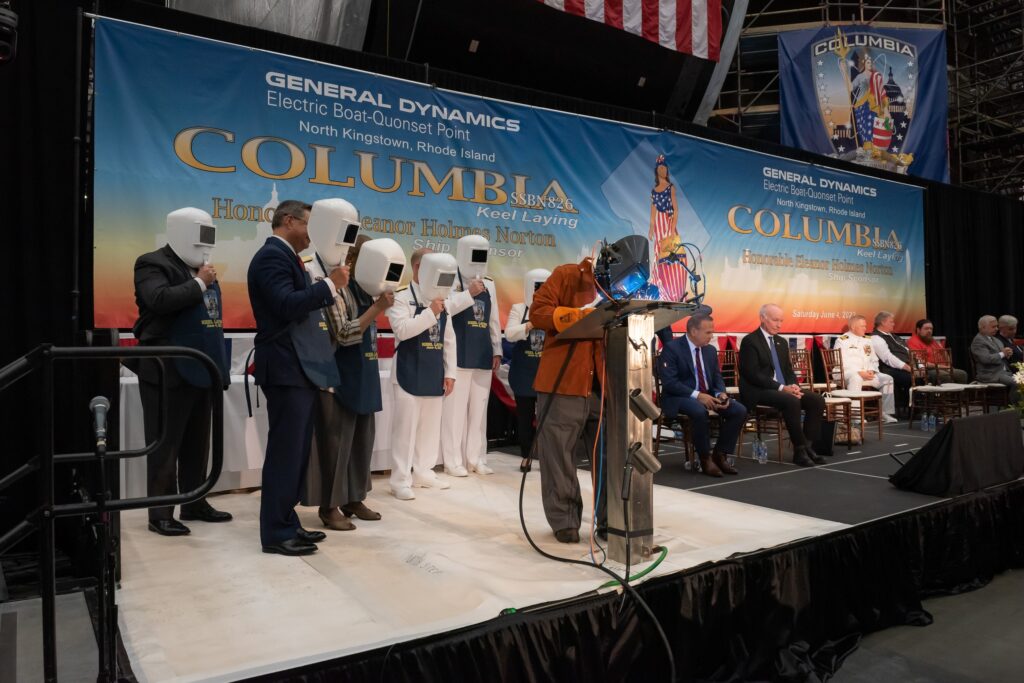
ARLINGTON, Va. — The admiral in charge of building the Navy’s next-generation nuclear-powered ballistic-missile submarine said there may be an advantage to building more than the 12 planned boats.
“I have clear data that says, ‘It clearly makes more sense to have more than 12 [Columbia-class SSBNs] to meet the current requirements that [U.S.] Strategic Command has defined for us,’” said Rear Adm. Scott Pappano, program executive officer for Strategic Submarines, speaking during a June 9 Hudson Strategic Forces Seminar in Washington.
“I have the data that will show the risks of what the current program of record is, and here is how those risks are mitigated if I go to 13 or 14 or 15 or 16, how that affects those requirements,” Pappano said. “It’s probably a late ‘20s decision, sometimes before the end of the next block that we are doing.”
The current U.S. Nuclear Posture Review defines the requirement for “at least” 12 Columbia-class SSBNs.
Pappano said building extra SSBNs would not be a technological problem but a matter making decisions early enough to keep submarine programs on schedule.
“It’s really getting both the cadence for the Columbia class and to be able to get back on cadence for Virginia [attack submarine],” he said.
The contract for building the first new SSBN, the future USS District of Columbia, calls for delivery 84 months of formal program start. Pappano’s goal is to deliver the boat in 78 months. With the construction started during the COVID-19 pandemic, construction “got a little bit slower start than we wanted” so it was lagging slightly behind 78 months but still ahead of the required maximum of 84 months.
“It’s not only delivering [the lead ship] on time … but we’ve got to get the cadence right for the rest of the class,” he said. “We have to be delivering Columbia class at a one-per-year cadence [in fiscal 2026].”
With the future USS District of Columbia and USS Wisconsin under contract, the Navy originally had planned to build the next three boats in the next block to get economic order quantity of the SSBNs and the Virginia-class SSNs.
“We’re working right now with our stakeholders to include five boats in the second block,” he said, to make that block buy in 2026 and “at least a five-ship block” for the third block.
The 12 Columbia-class SSBNs will be replacing the 14 Ohio-class SSBNs that each are scheduled to be retired at 42 years of service. The first of the Ohio SSBNs to be retired will be inactivated in 2027.
“There is going to be a period of time [for] much of the ‘30s we have to have 10 ships ready for sea, out of a depot period, and we’re going to have exactly 10 for a lot of that time,” Pappano said. “If you look at it month by month, there are periods where we might dip below nine.”
He said the Navy is looking at starting advance procurement for each boat “a little bit early… about six monthsish” for Columbia boats two through 12, a plan supported in the 2023 budget request.
The first Columbia-class SSBN is required to be on patrol in the first quarter of fiscal 2031. Pappano said the Navy is looking at squeezing more service life out of five Ohio-class boats with short service-life extensions of the boats that are in the best condition. The admiral said that fiscal 2026 would be the time to make the decision, with the first Ohio extension completed in fiscal 2029, and each taking three years.
Pappano said one advantage of extending an Ohio-class boat is during the 2036-2039 time frame, a submarine will be needed to test-launch the D5LE2 version of the Trident ballistic missile in support of the Strategic Systems Program. This would avoid having to take a submarine off the strategic deterrence patrol cycle to test the missiles.
- SECNAV Advocates Increased Legal Immigration to Increase Shipbuilder Workforce - April 23, 2024
- Insitu Going Strong at 30, Focusing on Maritime Operations - April 8, 2024
- Navy Awards Boeing Additional Funds for MQ-25 Drones for Testing - April 3, 2024






